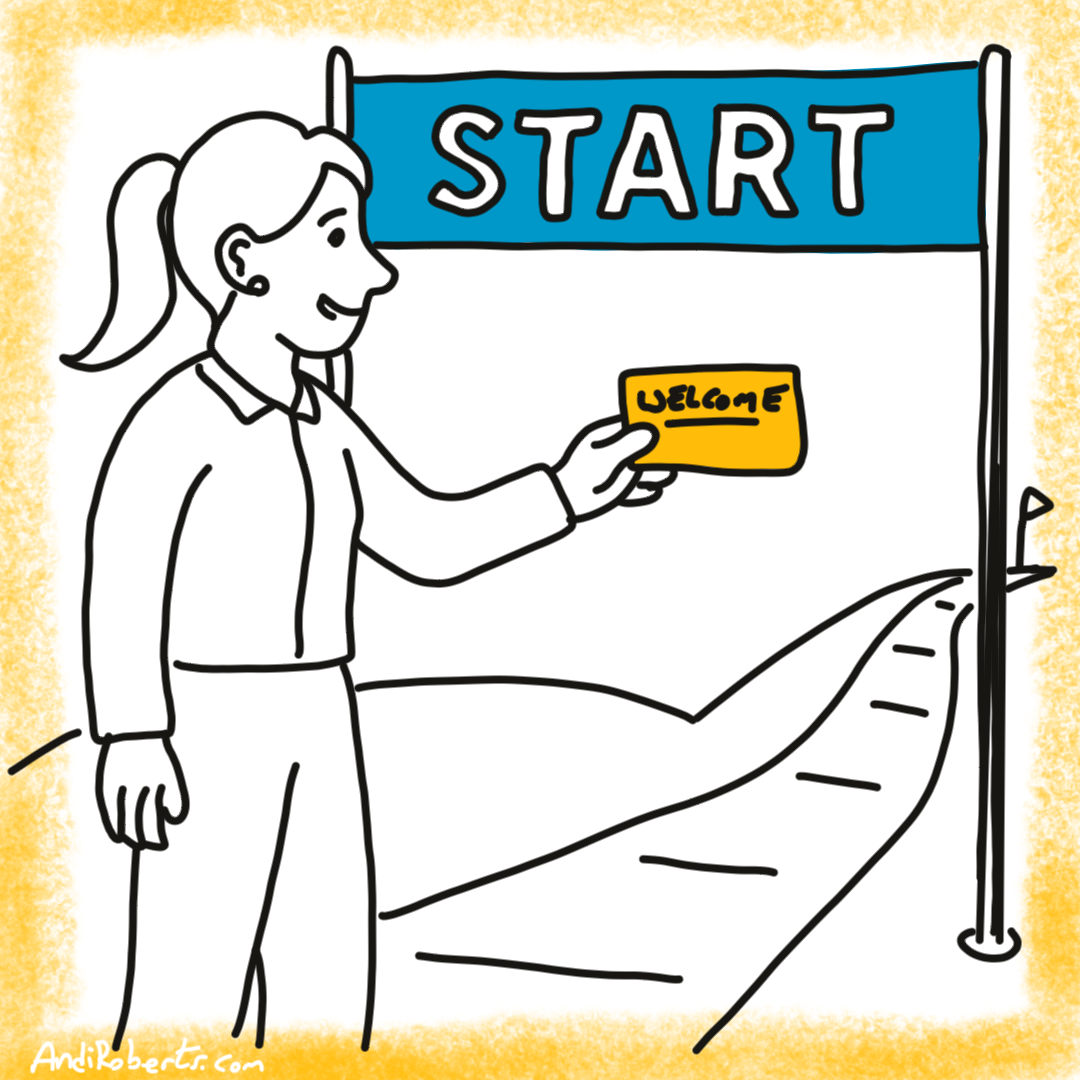Leaders are often judged not by the presentations they prepare, but by the questions they did not expect. In meetings, interviews, or town halls, a difficult question can shift the whole room. Eyes turn, silence stretches, and pressure rises.
In these moments, it is common to react quickly. We rush into words to fill the space. We over-explain to prove we have thought things through. At times, we become defensive or try to move the conversation elsewhere. These reactions are understandable, but they rarely build confidence. People hear strain instead of clarity.
There is another way. What if a tough question was not a test to survive, but an invitation to lead? Not through the perfect answer, but through presence, connection, and a clear, disciplined response.
What follows is a sequence you can practise, a way of holding the moment with composure and guiding the conversation forward.
Five-step process for tough questions
Step 0: Hold the silence and thank the person
Silence is powerful. Studies in psychology show that slower responses are often perceived as more thoughtful and credible, while rushed ones can appear less sincere (Cassella, 2021). By pausing, you claim the moment instead of letting it claim you. And thanking the person builds connection. Gratitude reframes the dynamic: this is dialogue, not combat.
You are asked, “How can you justify spending more on training when budgets are being cut?”
You pause, breathe, sip water, then say: “That is an important question. Thank you for raising it.”
Step 1: Identify the issue
Questions are often loaded with sub-issues, anxieties, or politics. Behavioural science shows that the way we frame an issue heavily shapes how others understand it (Tversky & Kahneman, 1985). By naming the real issue, you help people focus on what matters most.
“The issue is not training costs, but how we sustain capability in a leaner environment.”
Or: “The issue is not hybrid work itself, but team cohesion across different schedules.”
This reframing shifts the conversation from fog to clarity.
Step 2: State your point of view
In high-pressure moments, clarity is more valuable than detail. Research on conversational constraints shows that being direct reduces confusion and helps listeners engage (Gudykunst et al., 1996). Leaders who hedge with “maybes” or “sort ofs” risk losing credibility.
“My view is that we should protect customer-facing investments.”
Or: “The way I see it, flexibility strengthens productivity.”
One sentence is enough. It is not just about being certain, but about showing presence.
Step 3: Back it up with evidence
A view gains weight when you anchor it in something beyond opinion. But the key is discipline: one strong piece of support is usually more persuasive than many scattered ones. Cognitive load theory reminds us that people can only process a limited amount of information at once; overloading them with multiple arguments reduces comprehension and impact (Sweller, 1988). Persuasion research also shows that concrete, vivid evidence is often more influential than abstract generalities (Nisbett & Ross, 1980).
Types of evidence you might draw on
-
A lived experience that makes the issue tangible
-
An analogy that reframes the problem in a relatable way
-
A single fact, statistic, or trend that grounds your point
-
An expert’s perspective that adds credibility
“When we cut service budgets last year, customer churn increased by 7 percent. We know the consequences.”
The evidence is not decoration. It ties your point of view back to lived reality and anchors the conversation in something others can recognise and trust.
Step 4: Suggest an action
Conversations under pressure often stall in analysis. Action research shows that learning and trust grow when dialogue is tied to a next step (Reason & Bradbury, 2008). Even a modest proposal creates momentum.
“I recommend delaying internal upgrades and targeting savings there.”
Or: “Let us extend the flexible work trial to another team and review results after two months.”
It is less about having the final answer, more about offering a path forward.
Putting it all together
Here is how the process sounds in full.
Budget Cuts
-
Issue: “The issue is how to respond to this quarter’s 10 percent reduction.”
-
Point of View: “My view is that customer-facing investments should be protected.”
-
Evidence: “Last time service budgets were cut, churn spiked by 7 percent.”
-
Action: “Let us delay internal upgrades and target savings there.”
Remote Work
-
Issue: “The issue is whether flexible schedules will damage collaboration.”
-
Point of View: “I believe flexibility strengthens productivity.”
-
Evidence: “In our pilot, one team increased task completion by 15 percent with no drop in engagement.”
-
Action: “We should extend the trial to another team for two months.”
Public Speaking Challenge
-
Issue: “The issue is whether our story is compelling enough to persuade funders.”
-
Point of View: “My view is that simplicity will resonate more than detail.”
-
Evidence: “When we tested two pitches, the shorter one landed stronger with stakeholders.”
-
Action: “I recommend refining the message to three core points and dropping the rest.”
Practice pointers
-
Anticipate: Sketch likely questions and practise using this frame.
-
Rehearse silence: Get comfortable with a short pause before responding.
-
Stay human: Remember that thanking the asker is about connection, not technique.
-
Close the loop: If an issue needs more time, commit to a follow-up by date.
Closing thoughts
Answering under pressure is not about cleverness. It is about presence, clarity, and stewardship of the moment. By pausing, naming the issue, stating your view, grounding it with evidence, and offering an action, you transform pressure from a test into an act of leadership.
-
In high-pressure moments, which step do you usually rush or skip?
-
How do you feel in the silence before answering?
-
Which step feels most natural to you, and which are the hardest?
-
If you treated tough questions as invitations to build trust, not tests of competence, how might that change your presence as a leader?
Do you have any tips or advice on dealing with tough questions?
What has worked for you?
Do you have any recommended resources to explore?
Thanks for reading!
Inspired by a session with Tim Birdsall, which he calls “On the Spot”.
References
Cassella, C. (2021) ‘A slower response makes you come across as more sincere, psychologists say’. ScienceAlert. [online] Available at: https://www.sciencealert.com/a-slower-response-makes-you-come-across-more-insincere-psychologists-say (Accessed: [date]).
Nisbett, R.E. and Ross, L. (1980) Human inference: strategies and shortcomings of social judgment. Englewood Cliffs, NJ: Prentice-Hall.
Reason, P. and Bradbury, H. (eds.) (2008) The SAGE handbook of action research: participative inquiry and practice. 2nd edn. London: SAGE Publications.
Sweller, J. (1988) ‘Cognitive load during problem solving: effects on learning’, Cognitive Science, 12(2), pp. 257–285. doi:10.1207/s15516709cog1202_4.
Tversky, A. and Kahneman, D. (1981) ‘The framing of decisions and the psychology of choice’, Science, 211(4481), pp. 453–458. doi:10.1126/science.7455683.
Gudykunst, W.B., Matsumoto, Y., Ting-Toomey, S., Nishida, T., Kim, K. and Heyman, S. (1996) ‘The influence of cultural individualism–collectivism, self construals, and conversational constraints on communication behaviour’, International Journal of Intercultural Relations, 20(1), pp. 113–136. doi:10.1016/0147-1767(95)00035-6.





Leave A Comment